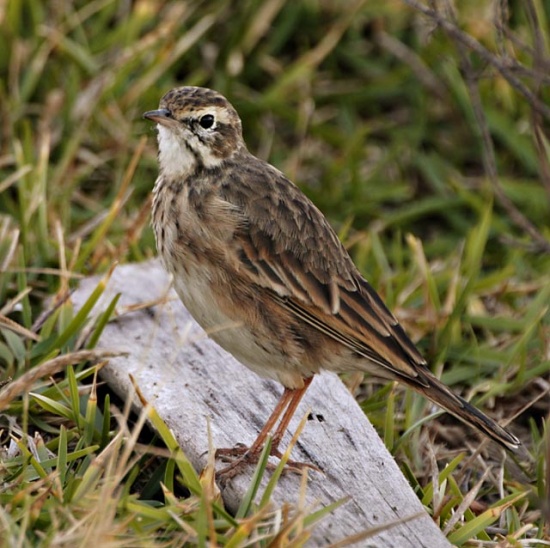- Anthus australis
Identification
Brown head and upperparts, streaked darker, prominent white eyebrow. White underparts, streaked brown on the breast and the outer tail feathers are white.
Distribution
Australia and New Guinea.
Taxonomy
This species was formerly a part of a much larger species called Anthus novaeseelandiae which was split in African Pipit, Mountain Pipit, Paddyfield Pipit, Richard's Pipit, New Zealand Pipit and Australian Pipit. Some authorities still consider it conspecific with New Zealand Pipit.
Subspecies[1]
- A. n. exiguus:
- Grasslands of central New Guinea (Mount Hagen to upper Watut River)
- A. n. rogersi:
- Northern Australia (Northern Territory to Gulf of Carpenteria)
- A. n. bilbali:
- South-western Australia
- A. n. australis (subaustralis):
- Queensland to Victoria and eastern South Australia
- A. n. bistriatus:
- Tasmania and islands in Bass Strait
Habitat
Rough grasslands, sand dunes and rocky terrain. Avoids agricultural areas.
Behaviour
Movement
Has the distinctive habit of flicking its long tail up and down. Long legs, jerky walk and often flies a short distance.
Diet
The diet is mainly invertebrates, especially beetles (including grass grubs), wasps, flies, spiders, crickets, moths and bugs, insect larvae and pupae and sandhoppers. They also take seeds of grasses, clover and weeds.
Breeding
Some pairs remain on territory all year and breed year after year. The female builds the bulky grass nest with a deep cup, which is usually well hidden at the base of a clump of grass, tussock, bracken fern, Manuka bush, or on the side of a bank. Between August and February 2-3 clutches of 2-5 cream eggs, heavily blotched brown with a darker zone at the broader end are laid. The female incubates for 14-15 days and both parents feed the nestlings which fledge at 14-16 days old.
Vocalisation
The common call is a shrill scree or drawn out zwee.
References
- Clements, JF. 2010. The Clements Checklist of Birds of the World. 6th ed., with updates to December 2010. Ithaca: Cornell Univ. Press. ISBN 978-0801445019. Spreadsheet available at http://www.birds.cornell.edu/clementschecklist/Clements%206.5.xls/view
Recommended Citation
- BirdForum Opus contributors. (2025) Australian Pipit. In: BirdForum, the forum for wild birds and birding. Retrieved 10 May 2025 from https://www.birdforum.net/opus/Australian_Pipit
External Links
GSearch checked for 2020 platform.1




